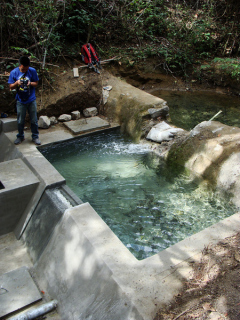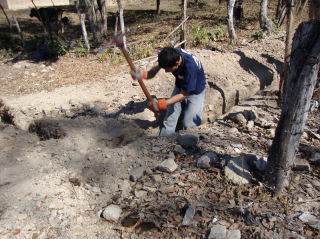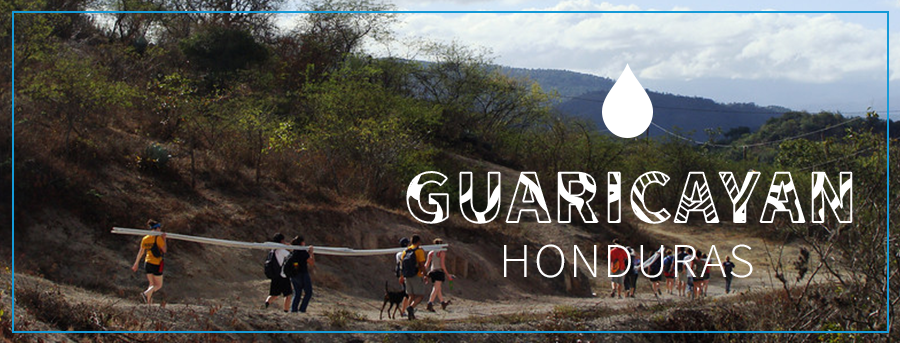
About Guaricayán
Guaricayán is a small community with a population of 185 people in the
municipality of San Juan de Flores. Prior to Global Brigades' arrival,
people in Guaricayán suffered from a lack of proper water, hygiene and
sanitation infrastructure, healthcare, and education. Colds, parasites,
and diarrheal disease were common. Few homes had concrete floors,
properly functioning latrines, proper water storage, or efficient stoves
with chimneys. School is offered until 6th grade, at which point most
children begin to work in agriculture to support their families. The closest
health center is over an hour walk away. The average family income is
estimated to be 2,400 Lempiras per month, which calculates to be less
than $1.00 per day.
Guaricayán's Water Challenge
Prior to Global Brigades' arrival, the community of Guaricayán was relying
on a water supply system that did not provide or meet local needs in terms
of quality and quantity. The previously existing water system was
constructed 24 years ago by the Honduran government. No monitoring
or follow-up was provided after construction. The original system was
constructed to supply a total of less than 20 households without taking
into account the growth of the community. Houses which were not
originally connected to the system were forced to get water by carrying it
from a nearby stream. Moreover, pipe diameters in the original system
design were not sufficient to provide water consistently to all the houses
that were connected. After functioning well for the first few years, the
system began to fail and people connected to the system were forced to
retrieve water from neighbors or streams despite the existing water system.
This infrastructural failure caused the community to stop treating its water.
The health center of El Zarzal, which serves six communities in the area
reported that Guaricayán has had the most cases of water and sanitation
related illnesses.
At the time, the Water Council had only five members who were not complying with any of their responsibilities. Due to lack of organization in the Water Council and poor water service, the vast majority of community members were not paying the established 10 Lempira (US $0.50) water fee.
The Water Solution for Guaricayán
Water Brigaders from nine different universities worked in Guaricayán in
January and February 2011. During that time, these volunteers worked with
community members to:
• Construct a new dam
• Build and painted a new tank with a chlorinator
• Dig approximately 3,200 meters of trench and install pipeline
• Connect 33 houses, 1 school, and 1 church
• Supply each house with a water storage bucket
• Provide educational seminars to children in the community on water
and health related topics
 To ensure the sustainability of the project, a new seven member Water Council was established and trained by Water Brigades in addition to a Basic Sanitation Committee also trained by Water Brigades.
To ensure the sustainability of the project, a new seven member Water Council was established and trained by Water Brigades in addition to a Basic Sanitation Committee also trained by Water Brigades.
Guaricayán was a great example of a community which was not complacent in its situation, something that can be found in other rural communities where Water Brigades has worked. With minimal support from the government, community members in Guaricayán had been active in pursuing a water solution in their community up until Water Brigades arrived. With the incredible support of many brigade groups and all the people of Guaricayán, the project was finished with great success in only two months. All houses in the Guaricayán now have sufficient treated water in their homes.
| Water Brigades Chapters that Worked in Guaricayán |
||
| Water Brigades Chapter | Month | Volunteers |
| Johns Hopkins University | January 2011 | 7 |
| St. Louis University | January 2011 | 9 |
| Stonybrook College | January 2011 | 11 |
| University of Virginia | January 2011 | 12 |
| University of Southern California | January 2011 | 13 |
| Boston University | January 2011 | 15 |
| Mt. Allison University | February 2011 | 11 |
| University of Victoria | February 2011 | 11 |
| NC State | February 2011 | 14 |
Current Status
Last Visit: May, 2015
Guaricayán’s water system is functioning very well. However, less frequent cleanings have resulted in lower quality water for the community. The houses did have chlorine residues but little to nothing, so that means they were chlorinating but not enough, they need to increase the chlorine concentration from 4 to 8. The Water Council is concerned about many community members' failure to pay the water fee, which subsidizes system upkeep. If they continue to miss payments, then system maintenance could suffer. The GB team encouraged the Water Council members to step up in leadership in order to ensure that the dam is kept clean, water is propperly chlorinated, and the community members are educated on the importance of their payments to the sustainability of the project. This is an crucial time for the Water Council to insure that their water project continues to serve their community for the long term.
Visit Other Programs in Guaricayán
Global Brigades strives to implement a model of Holistic Development in communities through a system of collectively implementing health, economic, and education initiatives to strategically meet a community's development goals. Learn more about the other programs being implemented in Guaricayán:
![]() Medical
Medical ![]() Dental
Dental ![]() Engineering
Engineering ![]() Microfinance
Microfinance ![]() Public Health
Public Health ![]() Business
Business ![]() Architecture
Architecture![]() CHW
CHW
| Project Overview | |
| Beneficiaries | 185 |
| Volunteers | 103 |
| System Type |
Gravity |
| Project Cost |
$10,200 |
| Pipes Installed |
2,800 m. |
| Hours of Education |
15 |
| Storage Tank Volume |
5,000 gallons |
| Additional Information |
| General Community Profile |
| Water Methodology |
| Pre-Brigade Lesson Plans |
| Education Profile |
| Water Project Final Report |
| Follow Up Report May 2015 |
